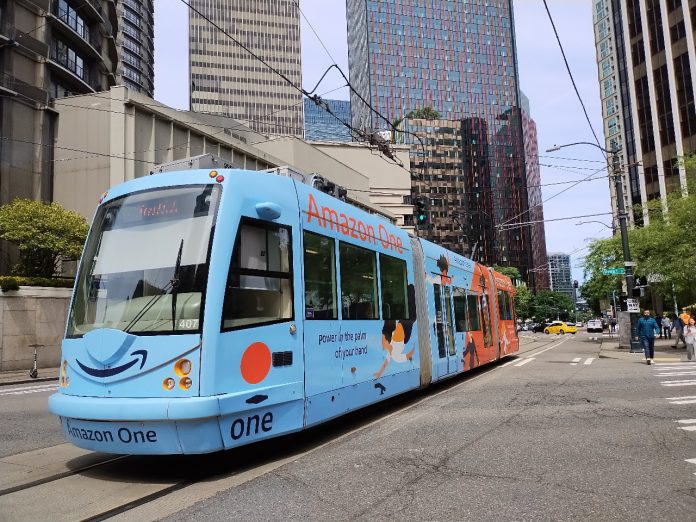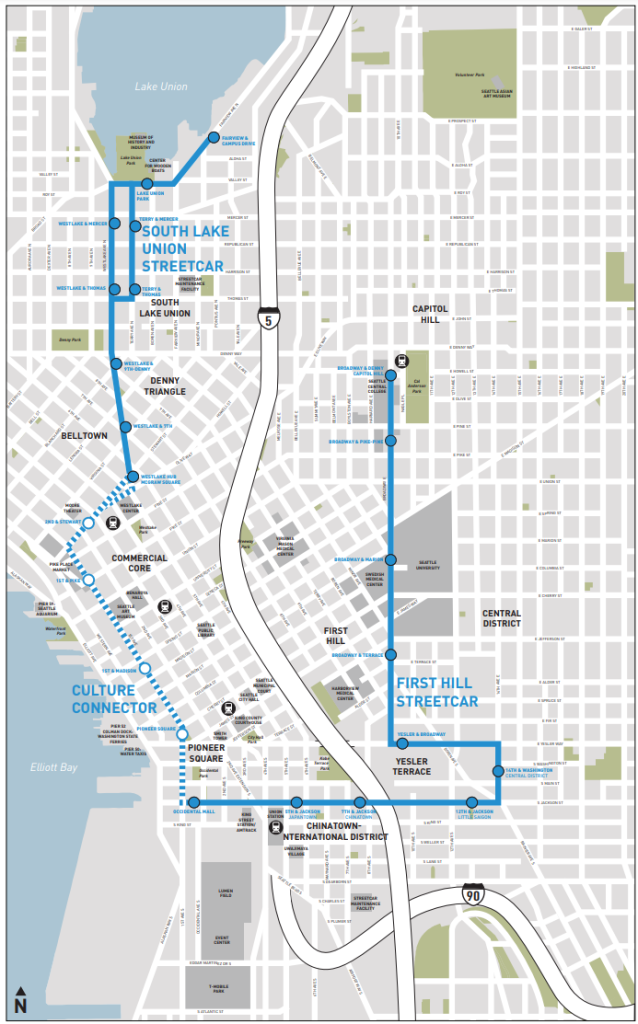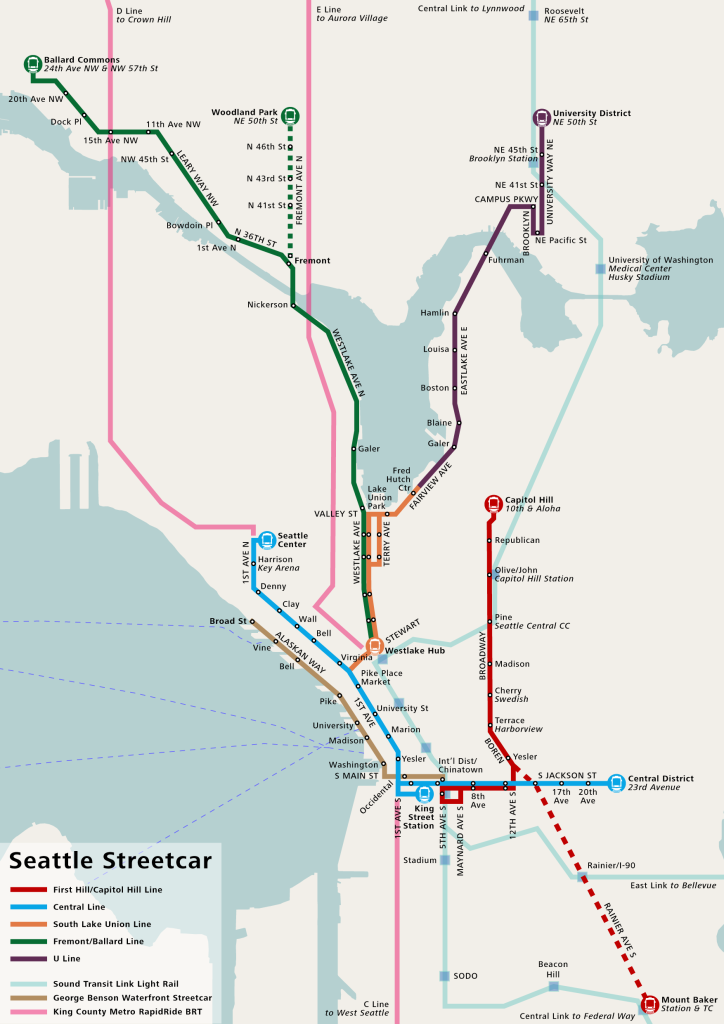
Councilmember Rob Saka has put forward a budget amendment asking the Seattle Department of Transportation (SDOT) for a plan to permanently cancel service on the South Lake Union Streetcar, which has operated since 2007. Councilmembers Bob Kettle and Cathy Moore have co-sponsored the amendment, which sets a deadline of next fall for “terminating South Lake Union Streetcar service, decommissioning South Lake Union Streetcar assets, and identifying alternative South Lake Union transit options.”
Another amendment sponsored by the same three councilmembers would also adjust the city’s Capital Improvement Program (CIP) to remove the Center City streetcar along First Avenue, which had been long-planned to finally connect Seattle’s two disconnected lines. The maneuver would officially dash hopes of securing funding and reviving the stalled project, which was placed on hold by former Mayor Jenny Durkan in 2018.
The Harrell Administration expressed interest in pursuing the project, now dubbed the Cultural Connector, until a new cost estimate of $410 million was released early this year, and it has remained on ice. The ill-fated extension project would create a connected five-mile streetcar system, closing the 1.2 mile gap between the 1.3-mile South Lake Union Streetcar and the 2.5-mile First Hill Streetcar.

The lower-performing of the city’s two streetcar lines, the South Lake Union Streetcar has seen ridership has remained low even as workers have returned to the neighborhood following the Covid-19 pandemic. Pre-pandemic, the line carried more than 500,000 riders per year, but since 2020 it has struggled to regain them.
In 2023, only around 175,000 trips were made on the line, with some daily ridership figures as low as a few hundred boardings. Contrast that with the First Hill Streetcar, which carried 1.27 million passengers in 2023, nearly returning to pre-pandemic ridership levels. At nearly twice the length of its SLU counterpart, the First Hill line connects more destinations as it runs between Capitol Hill and Pioneer Square.
Saka urged transit riders to look at the bright side of his “thoughtful” cut in a statement timed with a broader release of proposed budget amendments.
“As Transportation Committee Chair, I’m deeply concerned that residents aren’t getting what they paid for when it comes to the South Lake Union Streetcar. There are much more effective ways we could be investing our transit dollars and that’s why I’m proposing the executive take a serious look at alternatives with my amendment,” Saka said. “This isn’t about killing transit – it’s about ensuring our transportation dollars are wisely spent on expanded transit service in the area that people will actually use! At its core, this is a 1-for-1, transit-for-transit investment that would require a thoughtful transition of service.”

The Downtown Seattle Association (DSA), a long-time supporter of the streetcar, pushed back on Saka’s proposal.
“We’re seeing more residents, workers and visitors in downtown and now is not the time to take existing mobility options off the table,” the DSA said in a statement. “With looming major transportation projects like Revive I-5 impacting our network’s capacity, we need to ensure the transit modes we already have downtown are functioning optimally, safely and a providing great experience.”
Partially funded with $25 million from a local-improvement district (LID) collected from nearby property owners, the $53 million South Lake Union (SLU) streetcar was broadly seen as a real-estate development tool intended to spur activity in a former warehouse district that was rapidly transitioning into a tech hub. Transit options in the area were fairly limited at the time, and the streetcar was conceived initially as one part of a network that would ultimately cover much of the city.

Since 2007, bus options in SLU have improved, including the extension of West Seattle’s RapidRide C Line along Westlake Avenue N in 2016. Though some sections of the streetcar’s route include dedicated lanes, most riders are headed to destinations beyond the streetcar’s reach and it regularly becomes stuck in traffic at key pinch points like the intersections with Denny Way and Mercer Street.
Operating the South Lake Union streetcar currently costs around $4.5 million dollars per year, with passenger fares only bringing in around $800,000 as of 2022, the most recent year for which financial figures are available. Amazon, the neighborhood’s largest employer, currently contributes around $250,000 per year for streetcar operations, after purchasing several streetcar vehicles as public benefit as it expanded its campus and took over public right-of-way. Along with some other grants and station sponsorships, King County Metro does provide some funding to maintain operations on the line, but the lion’s share of funding to keep the line moving comes from City of Seattle dollars — dollars which could be diverted to fund other transportation projects.
Since 2023, the Harrell Administration has been filling the budget gap on streetcar operations using Seattle Transit Measure funding, which was approved by voters to pay for additional transit service as well as transit improvements and expires in early 2027.
The future of South Lake Union streetcar does face a critical decision point soon as Sound Transit prepares to start construction on the Ballard Link Extension project toward the end of the decade. With a station set to be built at Westlake Avenue and Denny Way, streetcar operations would have to cease for the eight years of station construction, unless the City of Seattle constructs a length of track connecting around the closure, a length of around 2,000 feet. Due to space constraints at the First Hill Streetcar’s maintenance facility, this is likely the only way the city would be able to move forward with building the Cultural Connector.

Saka’s amendment directs SDOT to create a plan “to identify the administrative and legislative steps necessary to decommission and dispose of South Lake Union Streetcar assets, including the South Lake Union Streetcar maintenance base, trolley vehicles, tracks, and traction power infrastructure.” And it asks for a plan to purchase additional bus service around South Lake Union “as a means to transition from streetcar service to other transit alternatives.”
Prior to this week, there was little indication that Saka was considering a push to eliminate streetcar service in South Lake Union. During a brief presentation on the streetcar network earlier this year at the transportation committee, he did probe Central staff on the history of the line, the reasons for a significant difference in ridership between the two streetcar lines, and other options for transit in SLU.
If the amendment passes, a final report would be due to the council by September 15 of next year. As a Statement of Legislative Intent (SLI), this amendment wouldn’t actually remove any funding for the streetcar. The proposal is set to be considered by the Council’s budget committee later this week, following a final public hearing on the proposed budget and all amendments Tuesday night at 5pm.
Update: This article was updated at 2:22pm Tuesday with the statement from the Downtown Seattle Association.
Ryan Packer has been writing for The Urbanist since 2015, and currently reports full-time as Contributing Editor. Their beats are transportation, land use, public space, traffic safety, and obscure community meetings. Packer has also reported for other regional outlets including BikePortland, Seattle Met, and PubliCola. They live in the Capitol Hill neighborhood of Seattle.

